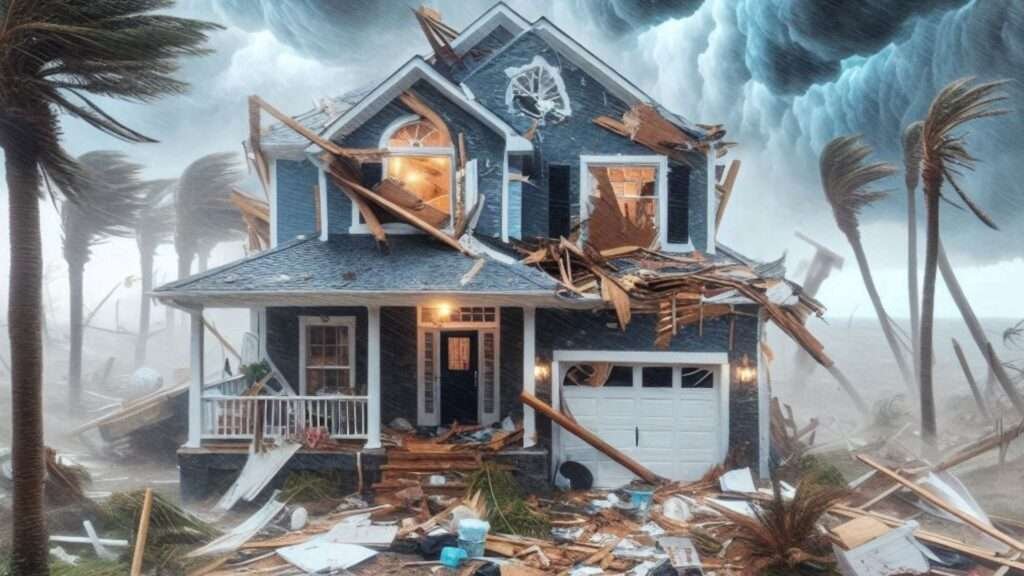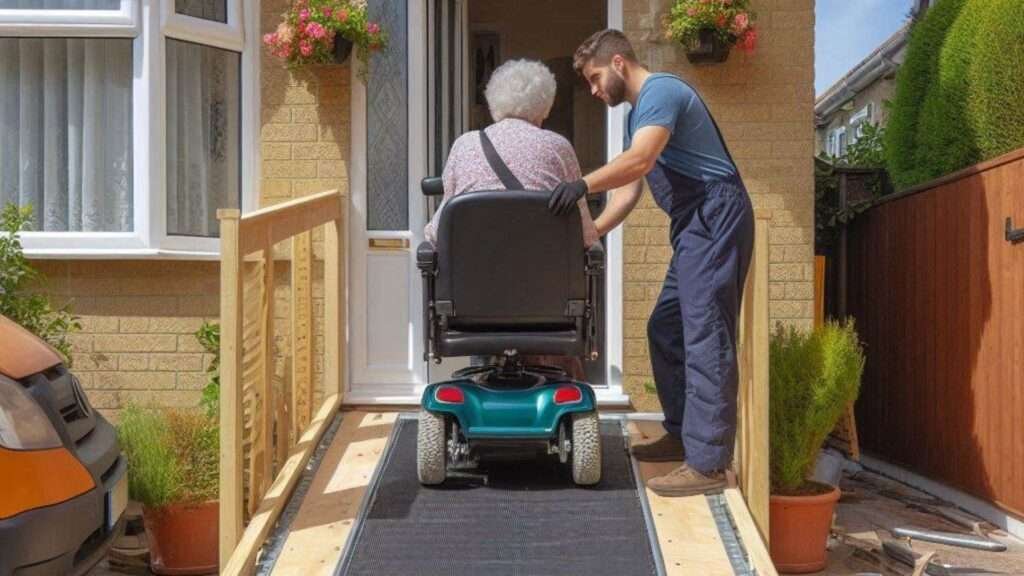Protecting Your Home From Major Storm Damage.
Major storms such as cyclones, hurricanes, and tornadoes can wreak havoc on homes and communities.
I’m not sure if it’s just me, but the frequency and ferocity of major weather events seems to be increasing year after year.
With that in mind, I suppose the best thing we can ever do is prepare for the worst-case scenario.
Understanding the distinctions and commonalities among these weather phenomena is crucial for effective preparation and mitigation.
Cyclones and hurricanes are essentially the same weather events but are named differently based on their location.
Cyclones occur in the South Pacific and Indian Ocean, while hurricanes arise in the Atlantic and Northeast Pacific. Both involve intense tropical storms characterized by strong winds, heavy rainfall, and potential flooding.
Tornadoes, on the other hand, are markedly different in their formation and impact. These violent windstorms develop from severe thunderstorms and are characterized by their funnel-shaped clouds.
Unlike cyclones and hurricanes, tornadoes can form quickly and with little warning, causing localized but catastrophic damage with wind speeds that can exceed 300 miles per hour.
Despite their differences, these major storms share common characteristics, including powerful winds, torrential rain, and the potential to cause significant structural damage.
When a cyclone/hurricane or tornado is approaching, the only thing that matters is your safety. The cost of fully preparing and securing your home is an investment in your future, not an expense.
There are numerous things we can do to prepare for these potentially disastrous and usually very dangerous storm events.
Tree trimming is a fairly routine task that should be done on a regular basis if you live in an area prone to cyclones or tornadoes.
When tree limbs break off in 300mph winds, they become a missile, smashing through or tearing a hole in your windows or roof as if they were made of paper mache in the most extreme cases.
When this occurs, there is usually additional damage to the inside of your home. Familiarise yourself with how to turn off the gas, water, and electricity before a cyclone or tornado hits your home.
At the very least, if you’ve turned off all of your services at the mains, you won’t be exposed to any additional risks if and when damage occurs downstream of those points.
Don’t leave items in your yard that can be converted into lethal flying objects by astronomically strong winds.
Tie down any items that cannot be safely stored away. Certified anchor points and tie downs can be used to secure sheds in place.
If you haven’t already, consider getting a quote for work as soon as possible.
Strengthen your home’s weak points with reinforcing materials and structures.
Install protection equipment such as storm shutters on windows and various types of protection screens to protect externally protruding air conditioning or evaporative air cooling units.
To protect your garage roller doors from dangerous storm events, consider installing storm shields/doors that can close in around the outside of them.
Get your roof inspected on a regular basis and repaired as needed to keep it storm-ready.
Carefully Evaluate and Then Address Your Home’s Storm Vunerabilities.
Homes can be particularly vulnerable to these forces, with risks ranging from roof damage and broken windows to severe flooding and even total destruction.
The aftermath of such events can leave families displaced and communities struggling to rebuild.
The importance of preparation cannot be overstated. General principles of storm safety include staying informed about weather conditions, having a well-stocked emergency kit, and securing your home against potential damage.
Reinforcing roofs, installing storm shutters, and ensuring proper drainage systems can mitigate the impact of these storms.
Additionally, having a clear evacuation plan and knowing the local emergency contact numbers can save lives and reduce the risk of injury.
By understanding the unique and shared attributes of cyclones, hurricanes, and tornadoes, homeowners can take proactive steps to protect their property and their loved ones.
Preparedness is the key to minimizing damage and ensuring safety during these powerful natural events.
Strengthening Your Home’s Foundation and Roof.
Ensuring your home can withstand the forces of major storms, cyclones, hurricanes, and tornadoes is crucial.
One of the most effective methods to enhance your home’s structural integrity is by installing hurricane straps.
These metal connectors are specifically designed to secure your roof to the walls of your home, thereby reducing the risk of roof lift-off during high winds. Hurricane straps are typically installed on new constructions, but they can also be added to existing structures during renovations.
Reinforcing roof trusses is another important step. Roof trusses form the framework of your roof, and strengthening them can significantly increase your home’s resistance to wind damage.
This can be achieved by adding additional bracing or using stronger materials. In some cases, retrofitting existing trusses with metal connectors and braces can provide additional support and stability.
This measure is particularly important for homes in areas prone to severe weather conditions.
Bolting your home’s frame to its foundation is another critical reinforcement technique. This method involves securing the wooden frame of your home to the concrete foundation using anchor bolts.
This helps prevent the frame from shifting or lifting off the foundation during strong winds.
The process typically requires drilling holes into the foundation and installing heavy-duty bolts that are capable of withstanding extreme forces.
These structural reinforcements are essential for minimizing damage during major storms.
Installing hurricane straps, reinforcing roof trusses, and bolting the frame to the foundation are not just precautionary measures but vital investments in your home’s safety.
By incorporating these techniques, homeowners can significantly reduce the risk of structural damage and ensure a safer living environment during severe weather events.
Window Protection: Shielding Against Flying Debris.
Windows represent one of the most vulnerable points in any home during major storms, cyclones, hurricanes, and tornadoes. Protecting them effectively can prevent significant damage and enhance overall home safety.
One of the most reliable methods of window protection is the installation of storm shutters. These shutters, often made from aluminium, steel, or polycarbonate, are designed to withstand high winds and impact from flying debris.
They can be permanently affixed or installed temporarily before a storm. The primary advantage of storm shutters lies in their robustness, providing a physical barrier that can be efficiently deployed when needed.
Another effective solution is the use of impact-resistant windows. These windows are crafted from multiple layers of glass and plastic, allowing them to absorb and dissipate the energy from impacts.
Unlike regular windows, they do not shatter upon impact, thus preventing dangerous shards of glass from flying into your home.
Impact-resistant windows integrate seamlessly into a home’s design and provide constant protection without the need for additional set-up, making them an ideal long-term investment for storm-prone areas.
For homeowners seeking a less invasive method, window films offer a viable alternative. Window films are transparent layers that are applied directly to the glass.
These films work by holding the glass together when it breaks, reducing the risk of injury from flying shards.
While not as robust as storm shutters or impact-resistant windows, window films can significantly increase the safety of existing windows. They are also relatively easy to apply and can be a cost-effective solution for enhancing window durability.
Each of these methods; storm shutters, impact-resistant windows, and window films, have their own advantages.
Storm shutters provide robust, deployable protection; impact-resistant windows offer permanent, built-in defence; and window films enhance existing windows’ resilience.
Homeowners should consider their specific needs, budget, and the frequency of storms in their area to select the most suitable option for safeguarding their windows against flying debris.
Ensuring the security of exterior doors is critical to making your home safe from major storms, cyclones, hurricanes, and tornadoes.
Doors that are not adequately reinforced can easily blow in under severe weather conditions, leading to extensive damage and endangering the safety of the occupants.
There are several effective methods to enhance door security, including installing heavy-duty deadbolts, reinforcing door frames, and using storm doors.
One of the most effective ways to reinforce your doors is by installing heavy-duty deadbolts. These deadbolts should be at least one inch long to ensure they provide the maximum level of security.
Additionally, it is advisable to use a deadbolt with a reinforced strike plate, which is mounted using long screws that anchor directly into the wall studs. This provides additional strength and prevents the door from being easily forced open.
Reinforcing the door frames is another essential step in ensuring door security. Standard door frames are often not strong enough to withstand the force of a major storm.
Installing metal or reinforced door jambs can significantly enhance the structural integrity of the door. These reinforcements can be installed by a professional or by using a DIY door reinforcement kit available in most home improvement stores.
Using storm doors is another effective method to secure your home’s exterior doors. Storm doors add an extra layer of protection and can shield the main door from flying debris and high winds.
They are designed to withstand harsh weather conditions and can be installed over existing doors without much hassle.
Moreover, storm doors also provide additional insulation, which can be beneficial in maintaining indoor temperatures.
Garage doors are often overlooked but are one of the most vulnerable points during a storm. Reinforcing garage doors is crucial to prevent them from buckling under pressure.
Installing vertical braces or using a garage door reinforcement kit can provide the necessary strength to withstand high winds. Additionally, ensuring the garage door tracks are securely attached to the walls and ceiling can further enhance their stability.
By taking these measures to secure exterior doors and garage doors, homeowners can significantly reduce the risk of damage and enhance the overall safety of their homes during major storms, cyclones, hurricanes, and tornadoes.
Water Management: Improving Drainage and Preventing Flooding.
Effective water management is crucial to safeguarding your home from the devastating impacts of major storms, cyclones, hurricanes, and tornadoes.
Implementing appropriate drainage solutions not only helps prevent flooding but also mitigates potential structural damage.
One of the foundational strategies is grading your yard to direct water away from the home’s foundation.
Proper grading ensures that water flows naturally away rather than accumulating around or beneath your house, which can lead to significant issues over time.
In addition to grading, installing French drains is a highly effective technique for managing water runoff.
French drains, essentially trenches filled with gravel and a perforated pipe, help channel water away from vulnerable areas.
This system can be particularly useful in areas prone to heavy rainfall, providing a reliable way to divert excess water.
Similarly, sump pumps offer another layer of protection by actively removing water that has collected in a sump basin, usually located in the basement.
By automatically pumping out water, these devices are invaluable during severe weather events.
Maintaining your home’s gutters and downspouts is equally important. Clean, functional gutters and downspouts ensure that rainwater is effectively directed away from the roof and foundation.
Regularly inspecting and clearing debris from these systems prevents blockages that could otherwise cause water to overflow and pool around your home.
Installing gutter guards can also minimize the accumulation of leaves and other debris, reducing maintenance efforts and ensuring consistent water flow.
By integrating these water management strategies, you fortify your home’s defences against potential flooding.
Properly graded yards, French drains, sump pumps, and well-maintained gutters and downspouts collectively form a comprehensive approach to managing water runoff and protecting your home from the severe effects of major storms.
Emergency Supplies: Preparing for Power Outages and Isolation.
When facing the threat of major storms, cyclones, hurricanes, or tornadoes, having a well-prepared emergency supply kit is crucial.
This kit ensures you and your family can remain safe and self-sufficient during power outages and periods of isolation. Start by assembling essential items that can sustain you for at least 72 hours.
Non-perishable food and water are paramount. Aim to stock a minimum of one gallon of water per person per day, and choose food items that require little or no preparation, such as canned goods, granola bars, and dried fruits. Don’t forget a manual can opener and utensils.
First-aid supplies are vital in addressing minor injuries and medical needs. Your kit should include bandages, antiseptic wipes, adhesive tape, pain relievers, and any prescription medications. Additionally, consider including items such as a thermometer and tweezers.
Flashlights and extra batteries are indispensable during power outages, providing necessary illumination and safety. LED flashlights are a great choice due to their longevity and efficiency.
A battery-powered or hand-crank weather radio is also essential for receiving real-time updates and emergency broadcasts. This ensures you stay informed about the storm’s progress and any evacuation orders.
Creating a family emergency plan is another critical step. This plan should outline evacuation routes, designate a meeting place, and include contact information for all family members.
Practice this plan regularly to ensure everyone knows their role and can act swiftly when necessary.
Lastly, staying informed through reliable weather updates cannot be overstressed. Follow local news channels, use weather apps, and subscribe to emergency alerts from trusted sources.
This information allows you to make timely decisions and take the necessary precautions to keep your family safe.
By preparing an emergency supply kit and having a robust plan in place, you can significantly enhance your home’s resilience against major storms, cyclones, hurricanes, and tornadoes.
Landscaping for Safety: Reducing Risk from Trees and Debris.
Strategic landscaping plays a crucial role in mitigating storm damage to your home. One of the primary steps is to ensure that trees and shrubs are well-maintained.
Regularly trimming trees and removing dead branches can significantly reduce the risk of limbs breaking off during high winds, which can become hazardous projectiles.
It is essential to inspect trees for any signs of disease or instability, as weakened trees are more likely to fall during storms.
Securing outdoor furniture and other loose items is another critical aspect of storm preparation.
Items such as patio furniture, grills, garden tools, and decorations can become airborne in strong winds, causing damage to windows, siding, and even people. Before a storm, it is advisable to store these items in a garage or shed, or to secure them with anchors or heavy-duty ties.
Choosing wind-resistant plants for your landscape can further enhance safety. Certain plants and shrubs are more capable of withstanding strong winds due to their flexible stems and deep root systems.
Native plants are often a good choice, as they are adapted to local weather conditions. Additionally, planting windbreaks, such as dense rows of shrubs or trees, can reduce wind speed and provide some protection for your home.
Regular yard maintenance is vital to prevent debris from becoming projectiles during high winds.
This includes keeping the lawn clear of fallen branches, leaves, and other clutter that could be lifted by the wind.
Regularly cleaning gutters and downspouts also helps prevent water damage and reduces the risk of debris accumulating around your home.
By adopting these strategic landscaping practices, homeowners can significantly reduce the risk of storm-related damage.
Proper tree maintenance, securing outdoor items, and selecting wind-resistant plants are effective measures to ensure that your property is better protected during extreme weather events.
Insurance and Financial Preparedness: Safeguarding Your Investment.
Ensuring your home is protected against the financial repercussions of major storms, cyclones, hurricanes, and tornadoes is paramount.
A comprehensive homeowner’s insurance policy is the cornerstone of this protection. Homeowners should thoroughly review their insurance coverage to understand the specifics of what is included for storm-related damages. Standard policies often cover wind damage but may exclude flooding, necessitating additional flood insurance coverage.
Before a storm hits, it is crucial to document the condition of your property. This can be accomplished through detailed photographs and videos of both the interior and exterior of your home.
Having a clear, pre-storm record simplifies the claims process and provides irrefutable evidence of the state of your property prior to any damage, which can be critical in ensuring you receive the full benefits of your policy.
Understanding the nuances of your insurance policy is equally important. Familiarize yourself with key terms such as deductibles, coverage limits, and exclusions.
Knowing the specifics of your policy will help in making informed decisions and ensuring that your home is adequately covered.
Additionally, it’s advisable to regularly review and update your policy to reflect any significant changes or improvements to your property.
The claims process can be intricate and time-consuming, especially following a major storm when insurance companies are inundated with claims.
Promptly reporting damages is vital. Keep detailed records of all communication with your insurance provider, including dates, times, and the names of representatives you speak with.
This organization can expedite the process and help avoid potential disputes over coverage.
Beyond insurance, financial preparedness is crucial. Establishing an emergency savings fund specifically designated for storm-related repairs and expenses can provide a critical financial buffer.
This fund should ideally cover at least three to six months’ worth of living expenses, ensuring that you have the necessary resources to manage immediate repairs and recovery efforts without undue financial strain.
Proper insurance coverage coupled with strategic financial planning forms a resilient defence against the unpredictable nature of major storms, ensuring that your home and investment are safeguarded.








